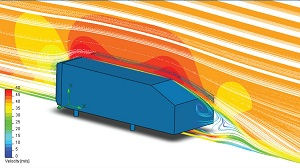Check it Out: Enhanced Turbulence Modeling in FloEFD
December 4, 2001
By Anthony J. Lockwood
Dear Desktop Engineering Reader:
 The goal of it all – design, analysis, prototyping, lifecycle management, and so forth – is to deliver the best product as efficiently and cost-effectively as possible. Now, you know that CAD-embedded CFD (computational fluid dynamics) plays a role achieving this goal in two key ways. First, by integrating high-quality, automated CFD analyses into the workflow of designers and mechanical engineers, you speed up your development stage and minimize the interpretive workload of expert CFD analysts, enabling them to be more productive. Second, by making high-quality CFD analyses of complex designs available from the front end of the product design cycle, the high-end analysis stages of the development cycle can keep up with the rapid pace of design changes.
The goal of it all – design, analysis, prototyping, lifecycle management, and so forth – is to deliver the best product as efficiently and cost-effectively as possible. Now, you know that CAD-embedded CFD (computational fluid dynamics) plays a role achieving this goal in two key ways. First, by integrating high-quality, automated CFD analyses into the workflow of designers and mechanical engineers, you speed up your development stage and minimize the interpretive workload of expert CFD analysts, enabling them to be more productive. Second, by making high-quality CFD analyses of complex designs available from the front end of the product design cycle, the high-end analysis stages of the development cycle can keep up with the rapid pace of design changes.
The kink in this scenario is when you go beyond simulating laminar flows and get into direct simulations of turbulent flows that take into account fluid volume fluctuations. Here, small physical sizes and the wide range of velocity fluctuations require fine computational meshes to resolve, long CPU times to simulate, and lots of memory to store results. As well, simulating fluid boundary layer effects near solid bodies or walls can be difficult to resolve due to high velocity and temperature gradients across these near-wall layers. And don’t forget shear flows, rotational flows, leveraging damping functions, and all sorts of other conditions that make turbulence problems a bear to resolve.
Mentor Graphics believes its general-purpose, CAD-embedded concurrent CFD software package FloEFD is up to these gnarly assignments. Today’s Check It Out white paper titled “Enhanced Turbulence Modeling in FloEFD” demonstrates why they hold that belief. It does so by benchmarking FloEFD against a range of CFD turbulence cases – as opposed to competitors; no hype in this work. These test cases include flow over a flat plate, turbulent Couette flow between two parallel plates moving in the opposite directions, flow over a backward-facing step, and unsteady air flow over a circular cylinder.
The paper explains the major physics theories covering such CFD problems, such as Launder & Spalding, Wilcox, and Lam & Bremhorst. It discusses how FloEFD uses the k-ε model with additional empirical enhancements to address a wide range of turbulent flow scenarios. Algorithms, figures, and images abound throughout this 20-page PDF.
I review and reject a lot of white papers for possible Check It Out columns. Many are really marketing pieces with scant technical illumination. I have to say that Mentor Graphics produces some of the most in-depth, technical documents I’ve seen. They do a number of things very well creating these documents, but what impresses me most is that they do not hype themselves even though they are writing about themselves and their product. In short, “Enhanced Turbulence Modeling in FloEFD” is a good read for the CFD connoisseur. Get it from the link over there.
Thanks, Pal.—Lockwood
Anthony J. Lockwood
Editor at Large, Desktop Engineering
Subscribe to our FREE magazine, FREE email newsletters or both!
About the Author
Anthony J. Lockwood is Digital Engineering’s founding editor. He is now retired. Contact him via [email protected].
Follow DE





